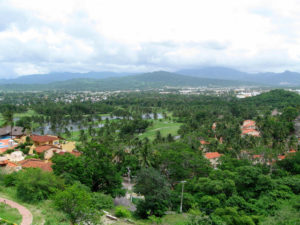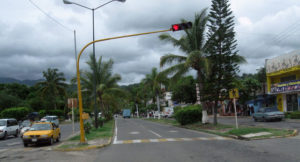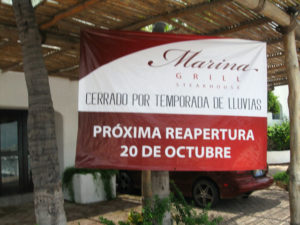In January 2010, I wrote in these pages about our visit to Xalapa, Veracruz, a city off the Gringo radar screen, and how it compared to Ajijic, a pueblo very much on it. This time, Patricia and I decided to sample a city on the Pacific coast — Manzanillo. It is a city certainly on the radar screen, but not overly popular with foreigners.
We decided to stay for the summer when the weather was at its worst. Friends thought we were nuts, but we decided the worst time was the best time. We live in Mexico year-round and can only afford one home here, so were we to live in Manzanillo; we would have to put up with its summers.
Manzanillo: the weather issue
The sad truth is Mexico’s coastal cities have wretched weather from about May through September. This year, the locals in Manzanillo said it was April through October. That’s seven months of bad weather! It is hot, more than 30 degrees Centigrade (86 Fahrenheit), and it cools little at night. Like most situations where the heat is unpleasant, it is the high humidity that makes it so uncomfortable. Air conditioning is unneeded in Ajijic at 6,000 feet above sea level. In the coastal cities it is indispensable.
Before buying our home in Ajijic, we had looked into Puerto Vallarta. It is more refined and cosmopolitan than Manzanillo. AARP says PV is the top foreign destination for retiring Americans. In its September/October 2010 magazine issue, it lists PV’s affordable housing, a large expat community for support, pleasant beaches, golf courses, food and wine festivals, opportunity for participation in charity among the attractions. There is no question it is pleasing. The walk along the mirador is a delight. Restaurants, bars, night clubs, shopping — Puerto Vallarta has it all. The same AARP article, however, mentions the hot, humid summers as the downside.
We had decided that, if we had to put up with unpleasant summer weather, we needed to have the pleasure of an ocean view. That seemed out of our reach in 2007 when we were house-hunting in PV. We also wanted to be in a house, not a condo. These two desires can conflict. Ocean views often are only affordable because you are part of a condo. So we had to trade-off on these interests.
Manzanillo: the beauty issue
Thus, the question was could we afford an ocean view in Manzanillo?

A quick study on the Internet suggests Manzanillo’s housing is more affordable than Puerto Vallarta. Lower prices in Manzanillo reflect its less glamorous appeal and lower level of development. In fact, Manzanillo is not pretty. I could have said it is homely. Or put it more bluntly, like a Mexican friend in Guadalajara told us when he learned about our visit: “It is in a very bad earthquake zone and is ugly, but you may like it. It has potential; it’s bound to grow.”
Puerto Vallarta needs to be pretty. First and foremost, it is a tourist town and must have charm to attract tourists. So, it cultivates an attractive image consistent with the expectations of pleasure-seekers on a vacation. It has a good beauty index.
Not so Manzanillo.
A drive north through Manzanillo
It doesn’t need to be pretty and makes little pretence about trying. Manzanillo is first and foremost a working port. It is Mexico’s busiest port as measured by tonnage and volume of containerized cargo.
Huge cranes, used for handling the containers, frame the skyline near the original part of the city. There is no scenic connection to the port, as in Veracruz, for instance. Also on the south end of town is huge power plant. It is on a grand scale with its smokestacks an eyesore, belching smoke visible for miles. There is project afoot to convert the plant to natural gas to clean-up the emissions. The power plant and the port, along with the headquarters of Mexico’s Pacific Naval Fleet, seem the economic stalwarts of the city. Tourism is certainly important, but it isn’t what catches the eye when you arrive in town from Colima.

It is useful to think of Manzanillo as two bays in an arc of some 20 kilometers with its southern point where the port and the town center are located. About mid way north, a peninsula juts straight out to sea to form another bay. Then another more sizeable peninsula, Juluapan, extends into the Pacific to form the northern limit of Manzanillo’s two bays. Let’s take a drive up the coastline on the principal roadway of town, Boulevard Miguel de la Madrid.
About 4 kilometers from the city plaza, the Manzanillo tourist area emerges after the Boulevard crosses the Laguna de las Garzas (crocodile sightings in this lagoon are reported tongue-in-cheek on the radio). The crossing is made to Playa Azul.
This area and the peninsula to its south, Las Brisas, is where the original beach front hotels were built. These beaches face the open sea so the water can be rough. The hotels show their age.
After several more kilometers of travel north, the shopping plazas start. You have passed most new car dealerships by this point. There is Wal-Mart, offering about the same fare as you would find north of the border, along with its competitors, Soriana and Comercial Mexicana. All three are “big box” stores and located near one another. You get excellent grocery shopping mixed with small stores in their periphery selling beachwear and tourist trinkets. The best of these is Plaza Manzanillo where Comericial Mexican is located. There is also Office Max, Starbucks, Burger King, KFC, and few other American franchises in the area.
That is about it as far as shopping goes in ZLO and is likely enough for most people. If you want anything classier, like a Liverpool department store, you will need to make the hour drive to Colima.
After Comericial Mexicana, the Las Hadas Golf Course starts and provides the first scenic backdrop along the boulevard. The golf course is first-class and its greenery extends for blocks as you drive north. Here Manzanillo is pretty.
If you turn west here on Avenida Audiencia and cross the golf course onto the Santiago Peninsula, you are now where, as the Mexicans say, nice people live. The English word “nice” in Mexico can take on the meaning of wealth or refinement. So this is the best part of town.
This is the site of the famous Las Hadas Hotel, which has the best marina and beach in town, for my money, along with other upscale lodging, including the spectacular Barceló Karmina Palace and numerous fashionable condos.
At the end of the peninsula is La Punta, an exclusive gated community of million-dollar plus homes, the poshest neighborhood of Manzanillo. If you can talk you way in (we did but knew someone) you will be amazed by the show of wealth and spectacular views.
Returning to the Boulevard and heading north, you quickly reach the edge of Santiago, a small pueblo wedged into Manzanillo’s march northward. If you turn right into Santiago you will be transported into a Mexican pueblo complete with its mercado in a matter of a few blocks. There is nothing charming about Santiago but one can shop like a Mexican and quickly escape Gringolandia here. Here is where you will find fresh fish and meat markets, can get household items repaired, buy flowers, gains, fruits, bread — in short, items in the form typically found in a pueblo.
Return to the Boulevard and drive a kilometer or so north and you will encounter your first view of the beach from your car since you started the drive north. This is where the locals and Mexican tourists come to swim. This is Santiago Bay. It extends in a nice arc for a number of kilometers.
The recommended access to this beach is to drive a few kilometers north from Santiago to the gated community of Club Santiago on the left. This is another golf course, of nine holes and less luxurious than the Las Hadas course. It is flanked with fine homes. If you tell the guard you want to go to the beach, he will let you in. Turn left at the first intersection, Las Truchas, and drive to the end of this road and park. You are less than a mile from the gated entrance and have easements to the beach between the houses and condos. It is a beach with a lot of black sand, as most ZLO beaches are. No picture postcard white sand beaches are to be had in ZLO.
There is one more place that needs mention on this drive north out of town. That is the Juluapan Peninsula.
The peninsula is an imposing vertical piece of real estate jutting out to sea from the north end of Santiago Bay. You reach it shortly after passing the university as you exit town on the highway to Barra de Navidad. A left hand turn, just before you reach the pueblo of Naranjo, leads to the peninsula. A poorly maintained winding road goes to several developments with scenic views of Santiago Bay, the city and the open sea. Housing is spread out here and commercial development virtually non-existent.
I mention Juluapan because it is it is growing and upscale. Its views would appeal to most foreigners. The Juluapan Peninsula gets a very respectable beauty rating.
Manzanillo weather report
There was good reason the foreigners had gone when we arrived in June. I can report the summer was indeed miserable. The hot, humid weather is truly oppressive. Even cockroaches seek redress from the heat here. I’d never seen them inside a refrigerator until Manzanillo. Happily, the cold makes them lethargic, so they are easy to catch and remove. I can assure you a through cleansing followed their discovery.

As for us humans, we only have air conditioning in the bedrooms. That’s typical for Manzanillo. At times, we were tempted to take our meals in there. But the worst of it was mold in the closets. It wasn’t due to leaks, rather just the heat and humidity. My suitcase was covered with a green mold when I removed it from the closet shelf for a short trip. Anything with leather was a prime food for the mold.
Fortunately, by mid-August the heat wave broke when we got some tropical storms. Entering in September, the heat became tolerable, if unpleasant. Rains, which seemed gentle when we first arrived, became the classical tropical downpour by September, and lingered on later than is customary in the highlands. By late October, the weather could be called pleasant if it weren’t for the need of air conditioning to sleep at night. It took until the first week of November before the weather really cooled down enough to be called pleasing and the foreigners started to slowly reappear.
The seasonality of ZLO’s tourist establishments seems more marked than in Puerto Vallarta. I don’t remember Puerto Vallarta closing down for summer.
Here restaurants favored by expats are closed or on a reduced schedule. Gringo presence is sparse in the gyms. Owners say they are awaiting the return of the foreigners to ramp things up.
There are few Canadian or American plated cars. There is an informal club of expats called Mazamigos, but no one showed up at their supposed meeting site when we attempted to connect in July. The restaurant owner told us the club had their last meeting in April and wouldn’t be back until October.
The accompanying snapshot of a “closed” restaurant at the Las Hadas marina announcing it’s reopening in October (although blaming the closure on rain) sums up Manzanillo. (See picture gallery.)
Manzanillo traffic report and other good hings
Manzanillo seems the perfect size — neither too big nor too small. One of the first things a Mexican tells you, whether a native or not, is how tranquilo, or calm, the city is.
The 2005 census recorded an official population of 137,842. It’s probably more like 200,000 today. Still it has the feel of a pueblo. In fact that is how Mexicans here refer to Manzanillo and they mean it as a compliment.
If you have experienced driving in Puerto Vallarta or the horrendous traffic of Guadalajara you will be in paradise in ZLO. The traffic, or the lack of it, (take a look at the photos) is one of the real pluses of the town. It almost makes Manzanillo pretty. Of course, traffic will swell during Holy Week, but that’s true for all beach towns.
Mexicans roll their eyes when you mention conducting business in government offices. The Spaniards are said to have instilled Mexicans with the perversity of making such transactions Kafkaesque. So a real plus of Manzanillo is the ease of dealing with the bureaucracy here.
If you are a foreign resident in Mexico you must go to INM (Instituto Nacional de Migracion) on visa matters and to IMSS (Instituto Mexicano del Seguro Social) for your health insurance. These are dreaded trips because of the lines of people and unsympathetic clerks. In Guadalajara, it has taken me as many as three trips to the downtown INM office to get my visa renewed and I speak Spanish. Each occasion takes the better part of the day. So many foreigners hire a “gestor” to handle the paperwork. It’s not necessary in Manzanillo. Here the atmosphere is relaxed and the offices uncrowded, with clerks eager to help you. Score one big plus for ZLO.
Housing in Manzanillo
Showing its foreign influence, prices for the housing we looked at is primarily given in dollars. Mostly, it consists of condos.
I roughly divide the Manzanillo market into four sectors:
- Las Brisas, the original tourist area of the city I spoke of as we started our drive north,
- the Santiago peninsula, where the finest homes are located,
- Club Santiago, the area located on the bay and
- the Juluapan Peninsula.
Our budget is around $250,000 USD. The good news is we could afford a house in any of four areas, although with conditions. Those conditions are that we buy a lot and build the house ourselves.
We like the Santiago Peninsula best. It is the most urban.
The Juluapan Peninsula is our second choice. It is more rural and further from services. A decent view lot can be had in either peninsula starting at about $130,000 USD or so. One might be able to construct a 1500 square foot home for less than $100 USD per square foot. Or say a total project cost of as little as $280,000 USD. Not bad if you are willing to undertake a construction project in Mexico.I have a Scottish friend who is doing exactly that. For a 2300 sq. ft. house with a wonderful ocean view, he expects to spend a total of around $300,000 USD. I am watching carefully.
Our take on Manzanillo
Manzanillo does have warts. Every city has. It’s just they seem more visible here and there is small effort to cultivate what ZLO has to offer. Things could be done to beautify Manzanillo. Just better maintenance of public works would go a long way — repave the streets, spiff up the Boulevard with serious bougainvillea planting, paint the buses, etc. And the city is doing some of that in the Las Brisas area.
But more could be done. If city hall were to take a serious look at fostering a tourist image and dedicate meaningful resources to upgrading and beautification, Manzanillo could be, if not bride, a bridesmaid. As I write this, what appears as a major upgrade to the Boulevard is underway with improved traffic flow, concrete replacing asphalt paving, better pedestrian areas, etc.
Another deficiency is lack of cultural activities. Not much in the way of concerts, lectures or art fairs. Perhaps this simply reflects the blue-collar nature of Manzanillo. The university is strictly a business and technical school. I could find no courses in literature, the arts or adult education or when I spoke with the admissions office. Fortunately, Colima does seem to offer some cultural events and is connected by an excellent highway.
The good news is we may be able to afford a nice view home in Manzanillo, if we are willing to take on the risk and time (at least six months) of building it. At this point, the question is do we want to? We would do so in a flash if the weather was more agreeable and Manzanillo a bit more chic. We really like the people here. They are one of the best features of the town. We have a few months left on our rental and good weather lies ahead. We’ll see what happens.












